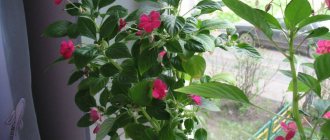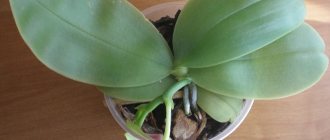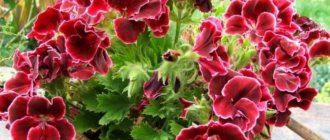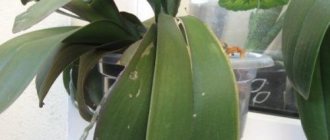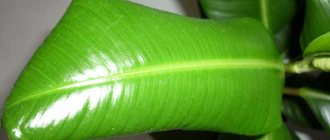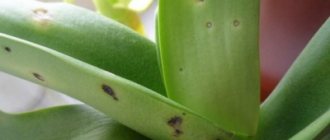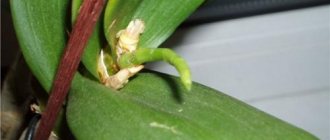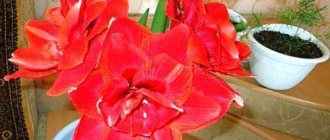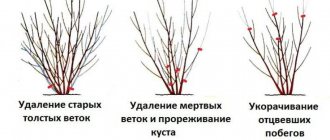The lifespan of orchids in the wild can reach hundreds of years. And those hybrids and varieties that were bred by breeders for breeding in greenhouses and apartments live much shorter. Their life expectancy depends on the conditions of their detention. Part of the care process is rejuvenation and replanting of plants. If you know how to rejuvenate an orchid correctly and on time, you can prolong its existence.
Flowering and life cycles of orchids - how they differ
The life period and flowering time of a plant are different concepts. Flowering begins at the moment the arrow appears and the buds form and ends after the flowers drop. The lifespan is counted from planting until the plant dies.
How long does it bloom?
The flowering period is determined by the conditions of keeping the orchid and its condition. As a rule, it can be long - from 2 to 6 months.
How many years has he lived at home?
The lifespan of tropical flowers depends on the variety. So, phalaenopsis is considered to be long-lived. With proper care, the plant can reach 7-10 years of age.
Post-rejuvenation care
With proper care, the cutting successfully takes root and turns into a full-fledged flowering plant.
The mother plant continues to be carefully looked after and within a few months, lateral buds form at its base, from which new plants develop.
Important ! Due to the fact that the bulk of the leaves were cut into cuttings, the evaporation of water was greatly reduced, and therefore watering the mother plant should be reduced .
Both cuttings and grown “babies” are planted in standard orchid bark + cut moss, like ordinary orchids.
What materials and tools need to be prepared
The most important thing is to choose a convenient cutting tool. As a rule, garden knives are used for cutting. But the trunk of the plant is quite hard, it is not always possible to cut it with a knife, so you can use pruning shears.
To restore the plant, you need:
- alcohol solution for cleaning instruments;
- brilliant green or cinnamon powder to disinfect cuts;
- a clean piece of soft fabric;
- pot with holes.
Additional landing capacity is needed because the trunk is divided into two parts. The old flower receives new life and at the same time reproduction occurs.
Experienced gardeners advise rejuvenation in the spring. At this time, with increasing daylight hours, the activity of biochemical processes inside the plant is maximum. The likelihood that it will take root well is high.
Stimulating flowering
If, after adjusting the care of the orchid, it still does not bloom, the formation of a peduncle can be stimulated using one of several methods.
Dry season simulation
The seasonal cyclicality of tropical rains and drought, characteristic of the natural growing conditions of orchids, can be used to stimulate flowering indoors. To do this, create an artificial dry season:
- the room temperature should not exceed 30℃;
- the interval between waterings is doubled, after which the plant is additionally kept in a warm room without watering for another 4-5 days, in a cool room - up to 7 days;
- the orchid is not sprayed or fed;
- When a flowering arrow appears, plant care is resumed, excluding fertilizing.
If the orchid had excess nitrogen in its diet, a dry season will help get rid of it and stimulate the formation of flower buds.
Warm shower for mild stress
This technique of simulating a tropical rainfall is suitable not only for stimulating growth and flowering, but also for hardening the orchid:
- the plant is watered before showering;
- the soil is covered with polyethylene to prevent water from getting on it;
- the water temperature in the shower should not exceed 35-40℃;
- duration of plant treatment – 10 minutes;
- After the procedure, the orchid is left for 20 minutes. in a closed bath so that the plant cools completely;
- Using a napkin, remove the remaining water from the axils of the leaves;
- In winter, the procedure can be carried out once a month, in summer – once every two weeks.
Important! Stimulation of flowering is carried out against the background of reducing the amount of nitrogen in fertilizing and increasing the content of potassium and phosphorus. To stimulate flowering, the optimal ratio of nitrogen, potassium and phosphorus should be 2:6:6.
How to divide an orchid
The technique for dividing a flower is as follows:
- The instrument is treated with an alcohol solution.
- The orchid is carefully removed from the planting container.
- The roots are cleared of soil and inspected.
- Dry roots are removed.
- Select an area on the trunk where to make the cut.
- The flower is quickly cut into two parts.
- The sections are treated with cinnamon powder or brilliant green.
- Within 24 hours, both parts are dried so that the sections begin to tighten and the risk of infection decreases.
Important! The cut site is the point above which aerial roots grow from the leaf axils.
So the orchid is divided into two parts. The young one has leaf blades and aerial roots, the old one has an existing root system; it may not have leaves.
When is it time to rejuvenate?
Phalaenopsis belongs to plants with a monopodial growth type. There is only one trunk and one apical growing point. Over time, the old leaves die off and the plant continues to grow upward.
Rejuvenation be taken seriously, since not every phalaenopsis needs this.
The rejuvenation process differs from replanting by trimming the upper part of the old phalaenopsis.
Reasons for rejuvenation may be:
- a large number of leaves;
- long stem and high above the substrate;
- abundance of aerial roots;
- the age of the orchid is more than 6-10 years;
- the orchid tilts out of the pot and falls on its side;
- It is impossible to plant normally without rejuvenation.
Important! The orchid chosen for rejuvenation must be completely healthy . No signs of bacterial, fungal infections or pests.
How to care for re-rooted plants
During the first week after re-rooting, the pots are kept in a warm, ventilated room. For additional illumination, a phytolamp is used. Then, when leaving, they are guided by the following rules:
- Watering. Until both parts are completely rooted, they are watered with a watering can, in moderation. The soil should dry completely between waterings.
- Spraying. This procedure is mandatory, especially if the air humidity is low. Warm water is used.
- Ventilation. Plants should be protected from drafts. But the room must be well ventilated to prevent the development of fungal diseases and rot.
Attention! You can evaluate how successfully you managed to rejuvenate and re-root in a month. The upper part by this time demonstrates active growth of the root system. New roots appear on the bottom, and trunk growth is observed.
Influencing factors
The main factors that influence the lifespan of an orchid are:
Growing conditions
In order for phalaenopsis to live as long as possible, you need to properly organize the environment in which it will grow.
First of all, this concerns lighting, since the roots of the plant need sunlight.
Direct sunlight is detrimental to the orchid. She may get leaf burns.- Lighting should be diffused. During hot summers, you can use a sunscreen to protect the flower.
- An important condition for the long life of a plant is temperature. The orchid is very sensitive to cold. Therefore, it is necessary to create comfortable conditions for its growth: from 20 to 25 degrees Celsius.
- Watering the plant should be done through a tray so as not to flood the aerial roots.
The orchid should be watered depending on the time of year and when the soil dries out. If water gets on the orchid leaves, they must be wiped with a dry cloth. - The humidity of the room in which phalaenopsis lives should be 40 - 45 percent. If it is not possible to achieve this indicator, it is recommended to use vessels with water in the room where the flower is located.
Transfer
The orchid undergoes the transplantation procedure very painfully. But it must be carried out once every 2–3 years. This helps renew the substrate and also protects the roots from rotting.
Feeding
In order to ensure a full-fledged existence of the orchid, feeding it is simply necessary. Currently, there are a huge number of different fertilizers that will have a beneficial effect on the health of the orchid.
Attention. You should not overuse fertilizers. This may delay the flowering period of the orchid.
Pests and diseases
Phalaenopsis is susceptible to a large number of diseases and is often a victim of parasites. Therefore, it is necessary to carefully inspect the plant for the presence of pests:
- scale insect;
- spider mite;
- rotten.
Timely control of diseases and parasites of phalaenopsis will significantly extend the life of the plant.
Preparing the soil for re-rooting phalaenopsis
The next point that needs to be taken care of is preparing the substrate. You can find many ready-made mixtures for planting orchids on sale. But from the point of view of their suitability for re-rooting phalaenopsis, not all of them are equally good:
| Substrate name | Manufacturer | Compound | Suitability for planting phalaenopsis |
| "Flower happiness Soil for orchids" | "Fasco" | Larch bark, high peat, charcoal, expanded clay | — |
| "Pokon Soil for orchids" | "Pokon" | Tree bark, high peat, lowland peat, lime, fertilizer | — |
| "Geolia Primer for orchids Premium" | Buysky chemical plant | Pine bark (55%), sphagnum moss (30%), charcoal. | + |
| "Orchid Garden of Wonders" | JSC "Fart" | High peat, dolomite flour, fertilizer | — |
| "Onega eco-soil for orchids" | LLC "Vermicom" | Pine bark, sphagnum moss, coconut substrate | + |
| "Veltorf Soil for orchids" | LLC "Veltorf" | A mixture of high-moor and low-lying peat, pine bark, limestone materials, fertilizer | — |
From the table above it is clear that choosing ready-made soil for orchids, with all the wealth of choice, is not an easy task. Therefore, in most cases it makes sense to prepare the substrate for re-rooting yourself. You can create it using any of the following options:
- 3 parts pine bark, 1 part fern roots, 1 part perlite;
- 5 parts pine bark, 1 part sphagnum moss;
- 3 parts pine bark, 1 part coconut fiber, 1 part expanded clay;
- 4 parts pine bark, 1 part charcoal, 1 part sphagnum moss.
You shouldn’t get too carried away with moisture-intensive materials, such as sphagnum. It is also strictly not recommended to add peat to the substrate.
Life cycle of a healthy plant
Observations show that the average flowering of an orchid lasts for about three months. This usually happens 2-3 times a year, with breaks for special dormant times, when the plant can rest and gain strength before flowering again.
If a healthy-looking orchid does not bloom, you should pay attention to the conditions of detention , because this is the main indicator of what is happening to your flower.
When is there cause for concern?
Usually blooming specimens are purchased at a flower shop.
In this case, they will drop their flowers in a couple of weeks or months. When will they bloom again and why is it taking so long? If adult orchids at home do not gain color after 1-1.5 years, then there is definitely cause for concern.
This time is enough for the adaptation period to end, and if the flower does not release an arrow, then something is going wrong in the life of the plant.
Landing
The volume of the pot should correspond to the size of the root system.
Pour expanded clay into a selected container and scald it with boiling water. On top there is a small layer of soil. We place the Phalaenopsis in the center and pour the substrate into the pot, periodically tapping it on the table surface. To protect the soil from drying out quickly, cover it with a layer of sphagnum moss.
To prevent Phalaenopsis from swinging in the pot and injuring the roots, at first we secure it with wooden skewers and a clip or wire. It will be possible to water it in 3-4 days.
Low humidity and temperature
The orchid is originally a tropical plant. Its homeland is characterized by high air humidity (70-80%) and temperatures of 25-30°C in summer and 20-23°C in winter. A necessary condition for flowering is a difference between day and night temperatures of 5-7°C.
Since it cannot be sprayed, air humidity is increased using:
- special humidifier devices;
- “company” of other plants;
- containers with cool water placed around the room;
- strips of damp sphagnum moss wrapped around a pot or placed in a tray, coconut fiber.
In winter, the pots are moved away from radiators and other heating devices that dry out the air greatly.
